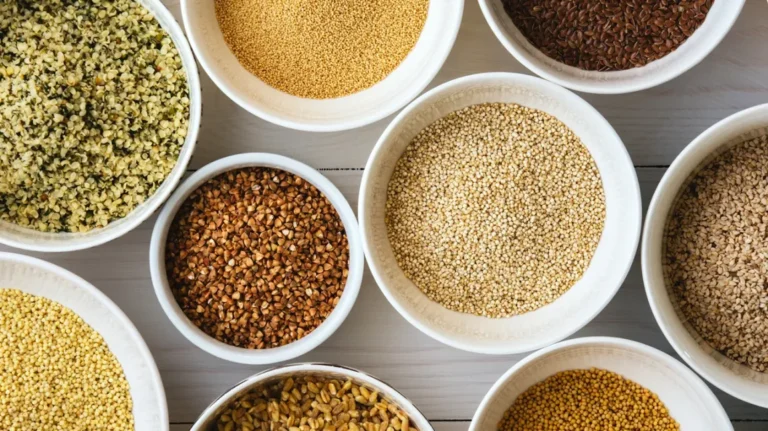Fiber is an essential component of a healthy diet, providing numerous benefits for digestion, weight management, heart health, and more. However, most people fall short of the recommended daily intake of 25 grams for women and 38 grams for men. On average, Americans consume only about 16 grams of fiber daily. If you’re looking to improve your fiber intake, here are 16 practical and easy ways to make it happen.
1. Choose Whole-Food Carbohydrates
Fiber is a type of carbohydrate found naturally in plant-based foods such as fruits, starchy vegetables, legumes, and whole grains. Unlike most carbs that break down into sugar, fiber remains intact during digestion, helping you feel full longer and regulating blood sugar levels.
Pro Tip: Incorporate whole grains, beans, and a variety of vegetables into your meals to boost fiber intake.
2. Start Meals with Vegetables
Non-starchy vegetables are low in calories and high in fiber. Eating them before your main meal can help you increase fiber intake and even reduce overall calorie consumption.
Example: Begin lunch or dinner with a salad or vegetable soup to enjoy these benefits.
3. Snack on Air-Popped Popcorn
Popcorn is a whole grain that’s surprisingly high in fiber, delivering 4 grams per ounce (3 cups of air-popped popcorn). For a healthy and flavorful snack, skip the butter and instead use spices like cinnamon or cayenne.
4. Grab a Piece of Fruit
Fruit is a natural source of fiber, vitamins, and minerals. High-fiber fruits like pears (5 grams), berries, and apples are not only nutritious but also portable for on-the-go snacking. Pairing fruit with protein-rich foods like nut butter can further enhance satiety.
5. Swap Refined Grains for Whole Grains
Whole grains retain their fiber-rich bran and vitamin-containing germ, making them more nutritious than refined grains. Replace white rice and bread with options like quinoa, farro, barley, or bulgur wheat for an easy fiber boost.
6. Consider Fiber Supplements
If dietary changes aren’t enough, fiber supplements can help. Options like psyllium, guar fiber, or glucomannan are available, though they should be introduced gradually to avoid bloating. Always consult a healthcare provider before starting a supplement, especially if you’re on medication.
7. Sprinkle Chia Seeds on Everything
Chia seeds are fiber superstars, offering 10 grams of fiber per ounce. They also provide omega-3 fatty acids and promote healthy digestion. Add them to smoothies, yogurt, or oatmeal for an effortless boost.
8. Choose Whole Fruits and Vegetables Over Juice
Juicing removes fiber, leaving you with a high-sugar beverage. Opt for whole fruits and vegetables instead to maximize fiber and reduce sugar intake. For instance, eat an orange rather than drinking orange juice.
9. Embrace Avocados
Avocados are packed with healthy fats and fiber, with half an avocado delivering 5 grams of fiber. Use them as a spread, salad topper, or substitute for butter in recipes for a creamy, nutritious boost.
10. Snack on Nuts and Seeds
Nuts and seeds, such as almonds and pumpkin seeds, are high in fiber, protein, and healthy fats. They make an excellent snack and can also be added to dishes for extra crunch and nutrition.
11. Use High-Fiber Flours
When baking, choose whole wheat, coconut, almond, or chickpea flour to add fiber to breads, muffins, and other baked goods. Coconut flour, for example, contains 10 grams of fiber per ounce, making it a great alternative to white flour.
12. Include Berries in Your Diet
Berries like raspberries and blackberries are among the most fiber-rich fruits, delivering 8 grams per cup. Add them to cereals, salads, or yogurt for a naturally sweet and fiber-packed treat.
13. Incorporate Legumes Regularly
Legumes, including beans, lentils, and chickpeas, are rich in both fiber and protein. One cup of cooked beans can provide up to 50% of your daily fiber needs. Add them to soups, stews, or salads for a filling and nutritious meal.
14. Keep the Peel On
The peel of fruits and vegetables is often the most fiber-rich part. For example, an unpeeled apple has 3.5 grams of fiber, while a peeled apple has less than 2 grams. Keep the skin on apples, cucumbers, and sweet potatoes whenever possible.
15. Check Food Labels for Fiber Content
If you’re buying processed foods like granola bars or cereals, read the nutrition label. Foods with 5 grams or more of fiber per serving are considered excellent sources. Look for functional fibers like inulin or polydextrose in the ingredient list.
16. Include High-Fiber Foods at Every Meal
Distribute your fiber intake throughout the day for optimal benefits.
- Breakfast: Choose oatmeal or high-fiber cereal topped with berries and nuts.
- Lunch: Add a side salad or whole-grain bread to your meal.
- Dinner: Incorporate beans and vegetables into casseroles or stir-fries.
- Snacks: Pair fresh fruit with nut butter or raw veggies with hummus.
Why Fiber Matters
Fiber is not only essential for gut health but also for managing weight, reducing the risk of chronic diseases, and maintaining healthy blood sugar levels. It’s a versatile nutrient that benefits nearly every aspect of your well-being.
The Bottom Line
Increasing your fiber intake doesn’t have to be complicated. By incorporating these simple strategies, you can enjoy the many health benefits of fiber while improving digestion and overall wellness. Whether you’re swapping refined grains for whole grains, snacking on fruits, or sprinkling chia seeds onto meals, every small change adds up.
Call to Action:
Start incorporating more fiber into your diet today! Share this guide with friends and family to spread the benefits of fiber and inspire healthier eating habits.








